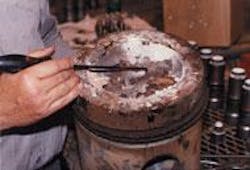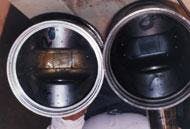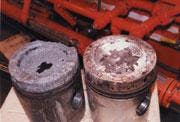Energy-producing sewage treatment plant solves engine corrosion problem
By John Brant
Operators of the Pima County wastewater (Roger Road) treatment plant in Tucson, Arizona, USA, save an average of US$ 30,000 a month in outside energy costs by using sewage effluent gas to fuel engines and generators. This strategy reduces environmental pollution by fuelling with gases that otherwise would be flared off to the atmosphere, and reduces the use of non-renewable natural gas resources. The Pima Plant handles 40 million gallons a day of raw sewage from the metropolitan Tucson area using an almost self-sufficient system.
The plant fuels six huge Waukesha engines and generators with sewer gas produced by anaerobic digestion of solid wastes. It uses heat from the engines to keep the gas-producing bacteria happily munching away, cleaning up the raw sewage.
The greatest challenge for plant operators was that the caustic, corrosive sewage gas could easily destroy the engines, ranging in cost from US$ 250,000 and higher. A specialty custom-blended lubricant from Phillips 66, a ConocoPhillips Company brand that can handle the acidic, chemically loaded fuel, solved the problem.
According to Lead Mechanic Tom May at the wastewater treatment plant, the Phillips 66 brand Eclipse "W"40 oil counteracts the extra stress that "sour" effluent gases put on the plant's six Waukesha lean-burn, gas-fired engines.
May explained, "Impurities from sour digester gas collect in the crankcase, diluting the oil, depleting its base reserve and spreading contaminants throughout the engine. A lubricant for the digester gas-fuelled engines must protect the engine by countering the effects of these corrosive impurities preventing deposits on critical parts and providing optimum lubrication over prolonged use."
"The (Waukesha) book recommends we should completely change the oil in a digester gas-fuelled engine after 350 to 500 hours," May said. "Using Eclipse W40 oil and regular oil analysis, we've extended our oil service intervals to between 600 and 800 hours. When we change oil at 800 hours, we've run the engine to the equivalent of 44,000 miles," he added. "So, we're doing better than synthetic heavy duty engine oils, which often stipulate recommended changers every 20,000 to 50,000 miles, even when fuelled with extra-clean fuel."
Further, before using Eclipse W40, the Pima County Plant had been replacing cylinders heads and rocker arm parts burnt through from sour gas deposits every 6,000 to 10,000 hours. "Eclipse W40 is on target to minimise piston replacement and keep all engine parts operating at peak efficiency. The aim is to extend the engine's life beyond 20,000 hours," May said.
The Waukesha engines used in the Pima plant are "lean burn" dual-fuelled (natural gas-digester gas) models, designed to meet US Environmental Protection Agency (EPA) emissions standards even with sour gas fuels. The engines use less fuel and more air because the gas-air mixture is compressed with turbochargers, precooled with intercoolers and injected into the engine so it burns efficiently.
Natural gas usually contains 900 to 905 British thermal units (BTUs) per cubic foot, while Pima's sour digester gas averages about 600 BTUs, May said.
"That treated, compressed, sour gas mixture fuels the engines that power our whole facility," May said. "We operate about 80% on generator power, so we don't have to buy power off the grid, further reducing our monthly energy costs. We're pretty close to being self-sufficient that way."
Energy-efficiency extends to other parts of the plant. Water heated by the engines' exhaust systems helps keep digester temperatures at the 96º F to 98º F preferred by anaerobic bacteria. These engines run 24 hours a day, seven days a week most of the time — some run 720 hours and equals 30 days a month. If they were on wheels, they would be running at 55 miles an hour, and would cover more than 39,000 miles.
Waukesha service bulletins specify the maximum total acid number (TAN) permitted in relation to the total base number (TBN) of the lubricating oil— measures vital to prolonging engine life.
Emory Sundberg, ConocoPhillips territory sales representative, said the Arizona waste treatment plant wanted specific TBN and TAN numbers not available with any off-the-shelf product, so ConocoPhillips blended the Phillips 66 product specifically for the plant. "We needed at least an 8 to 10 TBN," May said, "and the Waukesha engine service bulletin specifies a starting maximum of 1.5 parts per million TAN in relation with the TBN. That ratio must be maintained between oil changes."
Because Pima's fuel — primarily unfiltered digester gas — contains hydrogen sulphide (H2S), over time the TBN falls and the TAN goes up, so the oil must start with a higher-than-normal total base number to offset or neutralise the total acid number.
May said the sour gas fuel creates the need for a delicate balance in the oil. "If you have a high-ash, high-TBN oil in a sour gas fuel situation, the ash can actually become part of the problem in the pistons and can lead to detonation." Without high ash content, oil would quickly break down as impurities from the sulphur-rich (sour) gas build up inside the engine crankcase.
Ash content becomes even more of an issue when you start heating up these engines with turbochargers and lean-burn configurations — all of that puts extra stress on the oil," May said. "You need to prevent engine deposits from the ash, but you still need the right amount of ash, plus the TBN balance and stability to handle that high-level sulphur."
A major challenge is the amount of sulphur in the digester fuel gas. "We are actually running about as high a sulphur level as is possible in the fuel," May said. Waukesha recommends less than 0.1 parts per million (ppm) of H2S and elemental sulphur in the fuel — as close to zero as possible. "But we have run as high as 0.3 parts per million sulphur and H2S in our fuel, because we can't control it, and all that corrosive material really puts a strain on the engine lubrication system," May added.
Eclipse W40 helped May compensate for the digester gas fuel's high acid content. "During combustion, that high sulphur content can become sulphuric acid, which can eat up your bearings and other engine parts, and leave lots of deposits on your pistons." May said.
Before switching to Eclipse "W"40 oil, May had an engine torn down for repair and waiting for parts. "While we waited for the parts, we wrapped rags around the engine crankshaft to protect it. When the parts came in and we could complete repairs about a month later, we took the rags off and found they had disintegrated from the acid that was left in the oil on the crankshaft."
May runs engine-operating temperatures a little bit higher than normal, and relies on the acid-resistant characteristics of Eclipse "W"40 oil to help address the acid problem. "The Eclipse oil is designed to absorb the acids produced by the sour gas fuel," May said, "and to protect engine parts from acid for a longer period of time. This oil just doesn't break down quickly in the acid environment.
Author's NoteJohn Brant is the specialty programs coordinator at Phillips 66, based in Houston, Texas, USA.
Effluent lines bring wastewater into the Pima County treatment plant, where it enters through a pre-screening stage called head works, where screens remove the large pieces, such as weeds, rocks, trash and plastics.
Wastewater then flows by gravity down a long channel to clarifier tanks. The tanks have a tapered bottom and, as water flows through, more organic material is separated by floating to the top or sinking to the bottom of the tapered tanks. Those wastes are sent to a digester for treatment.
The water then goes to a biofilter system containing bacteria that eat more of the organic wastes and reduce odours at the plant. The water keeps flowing through the gravity system to a secondary treatment area where cleaning and biofiltration continue.
Large screenings are sent to the landfill. Bio-solids removed in the treatment process and digesters are sent to another Pima treatment plant, where it is thickened and sent to farmers for soil injection. The sludge of removed organics goes through a thickener and into the digester, where it is consumed by anaerobic digestion in about 15 days.
Pima's huge gas engines are fuelled with the by-product gas produced by mesophilic bacteria in this anaerobic digestion stage. The gas is captured under floating dome lids on the digesters, then compressed and chilled to remove most of the moisture from the gas, and to help remove other sedimentation and waste by-products.
The chilled gas then flows through the plant's main fuel gas system and directly into the engines; there are no holding tanks. "If we just let the digester gas blow off raw or burned it off in a flare, we might exceed the emission levels set in our environmental quality permit. Burning it in our engines is a lot cleaner," Tom May, lead mechanic at the wastewater treatment plant, said.




